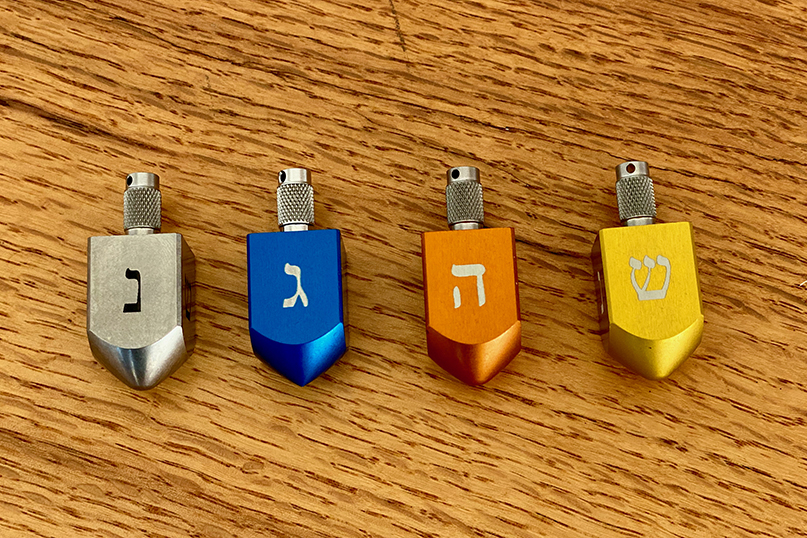
Horst Engineering creates limited-edition dreidels out of aircraft grade materials
By Stacey Dresner
Horst Engineering in East Hartford manufactures high-precision metal hardware components for global clients like the Collins aerospace division of Raytheon and General Electric Aviation.
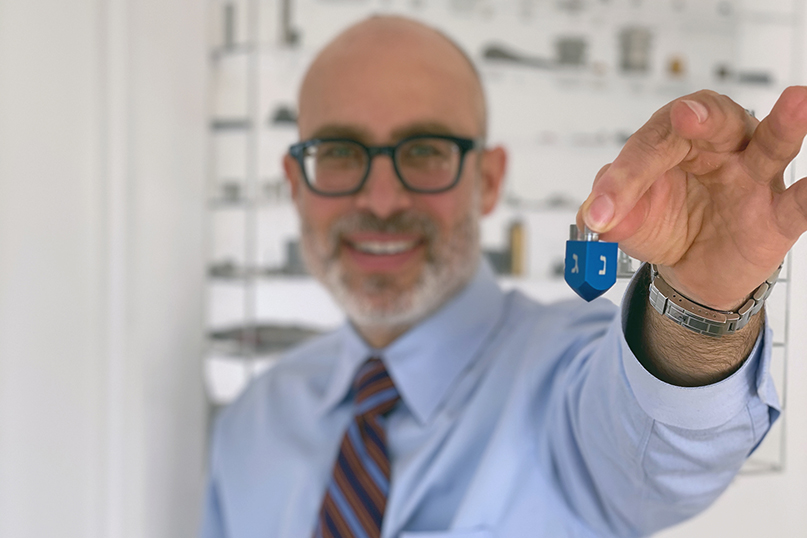
The company manufactures bolts, screws, studs, tie rods, nuts – among many other products – using materials like aluminum, stainless steel, titanium, and high temperature alloys and polymers. Horst parts can be found in a variety of aircraft systems in commercial aircraft flown every day.
The multi-million dollar company’s slogan is “We Lift You Up.”
Now Horst Engineering has diversified, using its premium materials to manufacture another sleek, high-tech, precision metal product – The Horst Dreidel.
The limited edition Horst Dreidel comes in aluminum, stainless steel or titanium, and is offered in three colors: blue, orange and gold. Each comes in a carrying pouch with a serial numbered certificate of conformance.
Horst’s website even has its own “dreidel” page, with videos explaining the history of the dreidel and how to play dreidel, as well as a recording of “The Dreidel Song” with written lyrics.
The company first made a batch of dreidels three years ago as a giveaway at a Horst Family Day – an event held every three years for employees and their families.
But now, as the coronavirus has grounded much of the commercial airline industry, Horst CEO Scott Livingston says that making dreidels has kept some of Horst’s idle machines busy.
“We do a large amount of defense business but we do an even larger amount of commercial airspace business and that is where the pain is being felt right now,” he told the Ledger. “We definitely have a little bit more capacity than we have had in the past few years. We didn’t have the time to do this up until February or March, so, yeah now there’s a little bit of machine time.”
Three months ago the company began churning out several hundred of the colorful Horst dreidels.
“This project could easily become a distraction when we have so many other worries going on,” Livingston said, “but it was a fun little project to do in a year where we could use a little joy.”
A design challenge
Over the years, Horst has designed and manufactured a number of small products to give away at its fun-filled Family Day events. Livingston says these aren’t just gifts, they are also a way to showcase what the company does.
As he was giving family members tours of the factory and its machinery, Livingston had realized that it wasn’t easy for the children to understand all of the ins and outs of manufacturing Horst’s small metal components.
“So we challenged our team from the first time we did one of these events to develop a product that kids can really identify with,” Livingston says. “Over the years we’ve done key chains, yo-yos, golf ball tees, little model airplanes, and tops. And then we said, ‘Well, tops are cool but how about a dreidel?”
Those first dreidels were made in 2017 with materials and machinery that the company already uses.
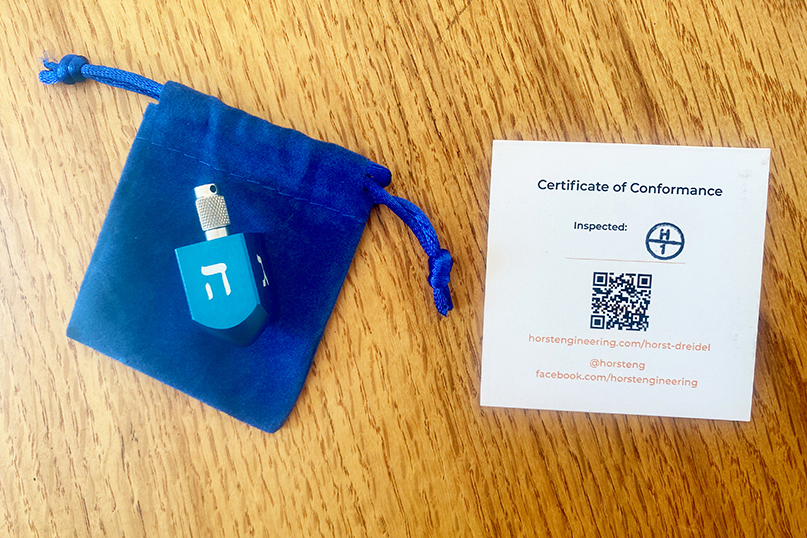
“We were demonstrating our processes, so the original design was an aircraft grade aluminum body with an aircraft grade stainless steel stem. And we wanted a two-piece design, so that way we could actually demonstrate more steps in the process…by making two pieces they were kind of modular and interchangeable, and we were able to demonstrate more of the steps.
“The aluminum body is made on what we call a Swiss screw machine,” Livingston explains. “If you are familiar with fine watches, the Swiss are the best. And they became so good they built their own machines to build their tiny watch parts. These Swiss screw machines can be used to make all different types of components, including aerospace components.”
The “Swiss” screw machines Horst uses now were made by a Japanese company, which has designed computer numerical control screw machines.
“So our dreidels are made on a Japanese Swiss screw machine – very high tech,” he said. “The stem is made on a different screw machine. It’s ‘thread-rolled; we roll the [metal] thread, which is high strength. We form the thread and roll the knurl, which is the little diamond pattern for the grip. You never want your dreidel to slip out of your fingers, right? How many times do you use a cheap dreidel and it slips out of your finger? Well, the knurl on this dreidel is surgical quality. It’s the same equipment we use for surgical instruments. The beauty of it is that we have all this capability and it is such a wonderful way to demonstrate it.”
Everyone at Horst’s 2017 family day event got one of their dreidels and they were a big hit.
“Of all the ideas we’ve had over the years for these family day events, the dreidel was the first one that I wanted to offer [for sale to the public]. Because people saw pictures of them and said, ‘That is beautiful, how do I get one of those?’ I said, ‘Well, you’ve got to come work at Horst Engineering.’”
A long legacy
Horst Engineering was founded in 1946 by Scott Livingston’s grandfather Harry.
Born Horst Rolf Liebenstein in Bad Liebenstein – a spa town in Germany – he graduated from the Technische Universität Ilmenau with a master’s degree in mechanical engineering.
While studying, Horst also worked at several factory jobs, including an apprenticeship at a bicycle factory. There he learned skills like metalworking and tool and die.
After getting his degree in 1935, Horst worked at a company manufacturing stationary bicycles and treadmills and calisthenics equipment for the local spa industry. He worked there for three years until things got so bad for the Jews that he knew he had to leave Germany. Horst’s two brothers had already left for Africa and were encouraging him to get out.
“His employer was sympathetic and ultimately helped him get to the Netherlands to get a boat in Rotterdam,” Scott Livingston says.
Horst’s parents, who owned a grocery store in Bad Liebenstein, would not leave and perished during the war.
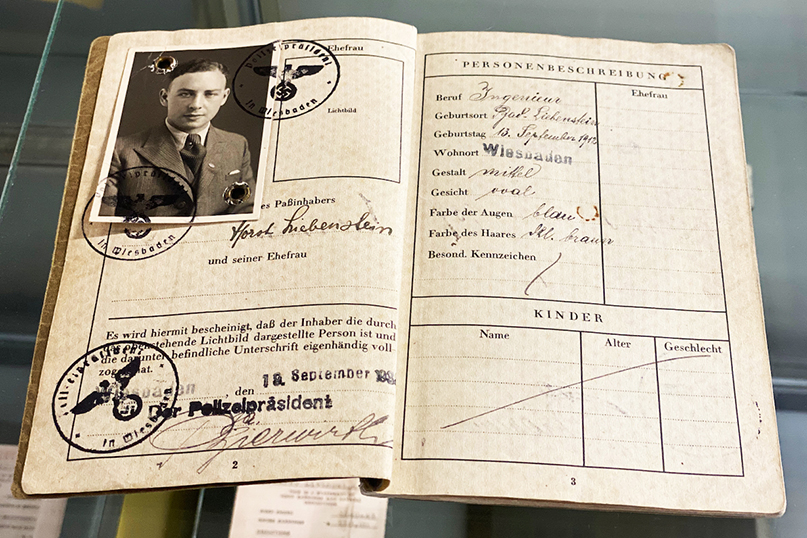
At 26, Horst made it to the United States where he was sponsored by cousins who had changed their last name from Liebenstein to Livingston.
So Horst Liebenstein became Harry Livingston.
“Ultimately he was able to make his way to Hartford in 1940 to seek industry, because this was a boomtown,” says Scott Livingston.
Harry married Sylvia Hurwitz, a Hartford native, and worked for a variety of companies in the Hartford area, including Whitney Chain Company, Johns-Hartford Tool Company, and Colts Manufacturing Company. Between 1940 and 1946 he learned different parts of the manufacturing trade before leaving to start his own business.
Harry founded Horst Engineering and Manufacturing Co. in 1946 opening up a shop in the rented second floor of a barn on Garden Street in Hartford. In 1950, with support from a great-uncle, Harry built the plant in East Hartford where it still stands today. In its early days, Horst Engineering specialized in making small parts for a broad range of industries.
In the 1960s and 1970s, under the leadership of Harry’s two sons, Stanley and Steven, the company acquired several other firms and began to specialize in the aerospace parts industry.
Next year Horst will celebrate its 75th anniversary by moving its 115 employees into a new, larger headquarters two miles away on Prestige Park Road in East Hartford.
“That will be a huge year. You’re not talking about generational transition you’re talking about a multi-generational transition. The company has evolved over the generations,” adds Livingston. “Today we make fasteners, including bolts, screws, tie rods, pins. We make specialized aircraft clevis pins. We make bodies bushings and sleeves, all different types of small super precision aerospace components that go into aircraft engines, cabin pressure systems, propeller systems, fuel controls, landing gear.”
The company also makes specialized metal parts for the bicycling industry – a connection to Harry’s time apprenticing for a bike factory in Germany in the 1920s. “A passion for cycling is in our roots,” Livingston says.
Now the Horst Dreidel – which includes the newer models with stainless steel and titanium bodies – can be found on the “Shop” page of Horst’s website, along with their patented “cross spikes” made for bicycle shoes.
“So we have the ability sell accessories or little items,” Livingston said, “and the dreidel is now another item in that shop,” although there are limited quantities.
Horst only created 384 of the aluminum dreidels, which sell for $54; 58 of the stainless steel dreidels at $58; and 56 of the titanium dreidels, selling for $72.
“Let’s put it this way,” Livingston jokes, “It isn’t going to pay for the new factory.”
North African Jewish women have a beautiful feminist Chanukah tradition
By Rishe Groner
Did you know that there’s a special Chanukah tradition – Eid Al Bnat (The Festival of Daughters, in Judeo-Arabic) or Chag HaBanot (in Hebrew) – that women and girls from North Africa’s Jewish communities have been celebrating for centuries? In Jerusalem last year, I joined a group of women of Middle Eastern and North African backgrounds who gather regularly to study their heritage with an organization called Arevot. We held an inspiring Eid Al Bnat celebration, with a focus on how to bring it back into our own communities this beautiful tradition.
Origins of the holiday
Celebrated on the Rosh Chodesh (New Moon) of Tevet (one of the Hebrew months where Chanukah takes place) in communities in North Africa and elsewhere, particularly the islands of Djerba and Tunis in Tunisia, Algeria, Salonika in Greece and Kushta (Istanbul) in Turkey, this day is filled with historic connections to powerful Jewish women. The festival takes the form of ceremonial gatherings featuring symbolic rituals, delicious treats and traditional songs, all focusing on bringing together generations of mothers, daughters, aunts, sisters and the extended community.
The stories of Chanukah and the ladies therein are often retold only as the story of Judith, the brave widow who fake-seduced the Greek-Syrian general Holofernes, fed him salty cheese and got him drunk on wine, then calmly beheaded him. The soldiers freaked out, the Maccabees won the battle and the rest is quite literally history.
But there’s another, lesser known story of a brave woman not named except as “the daughter of the Hasmonean, Yohanan the High Priest,” who lived in Judea (AKA modern day Israel) during the time of the Maccabees. Among the anti-Jewish edicts of the time, the invading governor insisted on sleeping with every virgin woman the night before her marriage, and this carried on for almost four years. On the night of the high priest’s daughter’s marriage, as she was about to be carted off to the governor’s chamber for the night, she uncovered her hair, ripped open her clothes, and exposed herself to all.
Amid cries of “send her off to be burned!” she turned to the crowd and said something along the lines of, “Are you kidding me? You think this is me being exposed – before my brothers and friends – but it doesn’t bother you that I’m about to be exposed before this foreign invading governor, sacrificing me to him?”
Her brothers, the Maccabees and Co., realized it was time to go off and kill the ruling governor. She got herself fancy and had herself escorted with dancers and musicians straight to the governor’s palace. Seeing the priestly family all caught up in this pseudo-wedding, the egomaniac governor let them right in, imagining they were handing off their daughter with voluntary joy. They utilized the opportunity to behead him and all his servants, which eventually helped bring the Maccabees to victory. The power of this woman’s vulnerability, honesty, and using her voice at just the right time is a fascinating tradition that we celebrate on this night.
How to celebrate
Like every tradition that gets passed down from generation to generation, there’s always a new flourish or nuance between how your grandma did it and how my aunt likes to do it.
In some communities, women visited the synagogue (not a thing that was usually done!) and kissed the Torah scrolls and were blessed by the rabbi; in others they cooked and baked a festive meal together, and then celebrated all night. Sweet traditional foods were prepared and gifted in baskets to mothers, daughters, or mothers-in-law, prayers were shared, and songs were sung. Overall, though, the key components always include lighting the Chanukah candles, lots of music and dancing, and the opportunity to create intimacy and community with women.
A song or piyyut often begins the night, followed by lighting the Chanukah candles. Piyyutim are liturgical poems written in Hebrew that are sung in incredibly complicated and deeply moving Arabic maqam (a system of melodic modes). For those of us without the ability to improvise our way through epic Hebrew poetry, you can pick out a song that is meaningful to you and that women can sing together. After that, the women traditionally recite a blessing of “Mi Shebeirach Imoteinu,” or, “May the One who blessed our Mothers bless us.” It’s a cool opportunity to improvise your own prayer and gratitude for the women who came before us.
Next comes the chance to go around and get to know everyone. It’s beautiful to encourage every woman to name their mothers and grandmothers as well, lighting a candle for each one in the center of the table, bringing our personal histories into the circle.
A communal bat mitzvah
One awesome tradition is the presentation of the bat mitzvah girls of the year – it’s up to the moms and aunts to cheer, bless, and generally love up these young girls as newcomers to the women’s circle. It’s also traditional to prepare foods together, like the North African favorite sfenj – think jelly doughnuts meet churros drizzled with honey – or honey cakes and cookies, or a potluck dinner. Mishloach manot – gifting packages of food and treats – is also part of the Eid Al Bnat tradition, so the Jewish mom Tupperware buffet is a must at this party!
The power of women’s circles
Since this festival is based on the stories of Judith and the daughter of Yohanan the Hasmonean, it’s important to tell, read or act out their stories, reflecting on the power of women. It’s also a good time to share the history of the holiday, passing on wisdom from generation to generation and sharing the customs across different cultures.
Women’s groups have a natural intimacy, so it’s fun to find ways to connect. In Jerusalem, we played a game that asked each woman to share a tip or a gift with another, which included everything from womb meditations to honeybee secrets to how to cope with mourning a loved one. You can share poetry, songs or just the best thing your mother ever taught you.
Whether you share stories, get vulnerable, cook up a storm, or dance the night away, this night is for us all to celebrate the power of the ladies in our lives, and the bonds that keep us strong in the face of struggle.
This piece originally appeared in Alma.
Israel Philharmonic to host virtual pre-Chanukah global music celebration
(JNS) American Friends of the Israel Philharmonic Orchestra and the Israel Philharmonic Foundation will premiere the “Israel Philharmonic Pre-Hanukkah Global Celebration,” a multidisciplinary program of instrumental performances and behind-the-scenes interviews, coupled with powerful messages of hope.
The Dec. 6 event will stream internationally, free of charge, to bring music and holiday light from Israel’s world-class Philharmonic to audiences around the world amid the global coronavirus pandemic.
The event will weave together word and song, featuring Academy Award-winning composer Hans Zimmer; Grammy and Tony Award-winning actress and singer Bette Midler; actress and star of Fauda Ronalee Shimon; actress and model Dar Zuzovsky; music manager Kenny Hamilton; and other special guests.
The Israel Philharmonic and its conductor, Lahav Shani, will perform pieces from Zimmer’s acclaimed works.
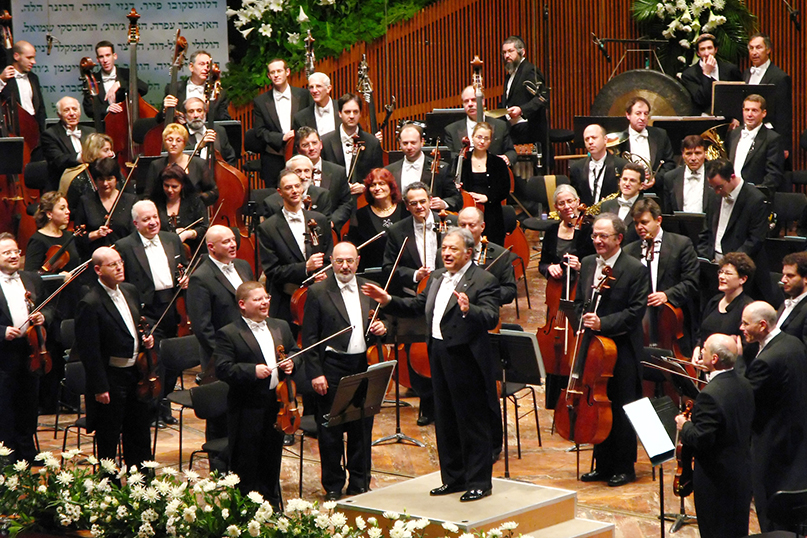
“The Israel Philharmonic is a shining light for humanitarian principles, artistic freedom and the tireless pursuit of excellence – and for continuing to provide accessible, inspiring digital musical content despite the pandemic,” said Danielle Ames Spivak, AFIPO executive vice president and CEO.
Tali Gottlieb, Israel Philharmonic Foundation executive director, said “2020 has been an extremely difficult year. We are making every effort to assist the philharmonic, and I am moved by the heartwarming response of its friends in Israel and throughout the world. In an end-of-the-year effort and in light of the exceptional success of our Global Gala this past June, which was viewed by more than 500,000 people worldwide, I hope this event will provide the support it needs to grapple with the enormous challenges still ahead.”
Registration is free. Donations will offset critical Philharmonic revenue losses due to forced closures due to the ongoing pandemic.
Donors will receive access to a VIP after-party with Christie’s global managing director Lydia Fenet and guests, discussing “Trendsetters and Tastemakers: Culture, Art, Fashion and Design in 2021 and Beyond.”







 Southern New England Jewish Ledger
Southern New England Jewish Ledger














